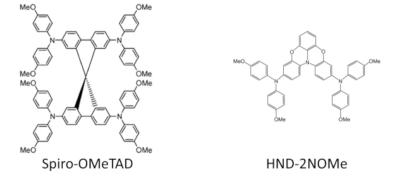Researchers at the University of Tsukuba and Kyoto University have studied the internal properties of low-cost materials used in perovskite solar cells that use HND-2NOMe, a replacement hole-transport material to spiro-OMeTAD, using electron spin resonance (ESR) to analyze these materials at a microscopic level.
Chemical structures of hole-transport materials spiro-OMeTAD and HND-2NOMe. Image from: Communications Materials
The results clarify the underlying causes for reduced device performance, despite high local charge mobility, offering critical insights for designing improved solar cells.
The scientists explain that a typical hole-transport material, spiro-OMeTAD, has associated difficulties including complex synthesis and high cost. To overcome these shortcomings, an easily synthesized and low-cost hole-transport material has been developed: HND-2NOMe.
HND-2NOMe molecules possess a quasi-planar structure that allows them to align in a one-dimensional overlapping manner and thereby facilitates charge transfer. Despite demonstrating high charge mobility, perovskite solar cells incorporating HND-2NOMe have shown performance limitations, such as reduced current, the cause of which is still unknown.
The team used ESR to investigate the underlying mechanisms for the performance limitations of perovskite solar cells incorporating HND-2NOMe, focusing on the material's internal properties at a microscopic scale. They discovered that in the absence of illumination, holes migrate from perovskite to HND-2NOMe, forming an energetic barrier at the perovskite/HND-2NOMe interface. This barrier impedes hole flow, leading to performance limitations. Furthermore, solar cells incorporating HND-2NOMe demonstrate reduced hole accumulation under solar irradiation, which contributes to the stability of the hole transport function.
Identifying the factors responsible for performance limitations while maintaining stable functionality represents a substantial breakthrough with important implications for formulating fabrication guidelines aimed at enhancing device performance. Furthermore, the aforementioned findings could serve as a valuable foundation for advancing future research and development in perovskite solar cell technologies.




